GearVR tracking system or electronics production in Russia
A dozen people once sat together in a bar. We talked, joked and suddenly thought: why not make a high-precision and high-speed tracking system for mobile VR.
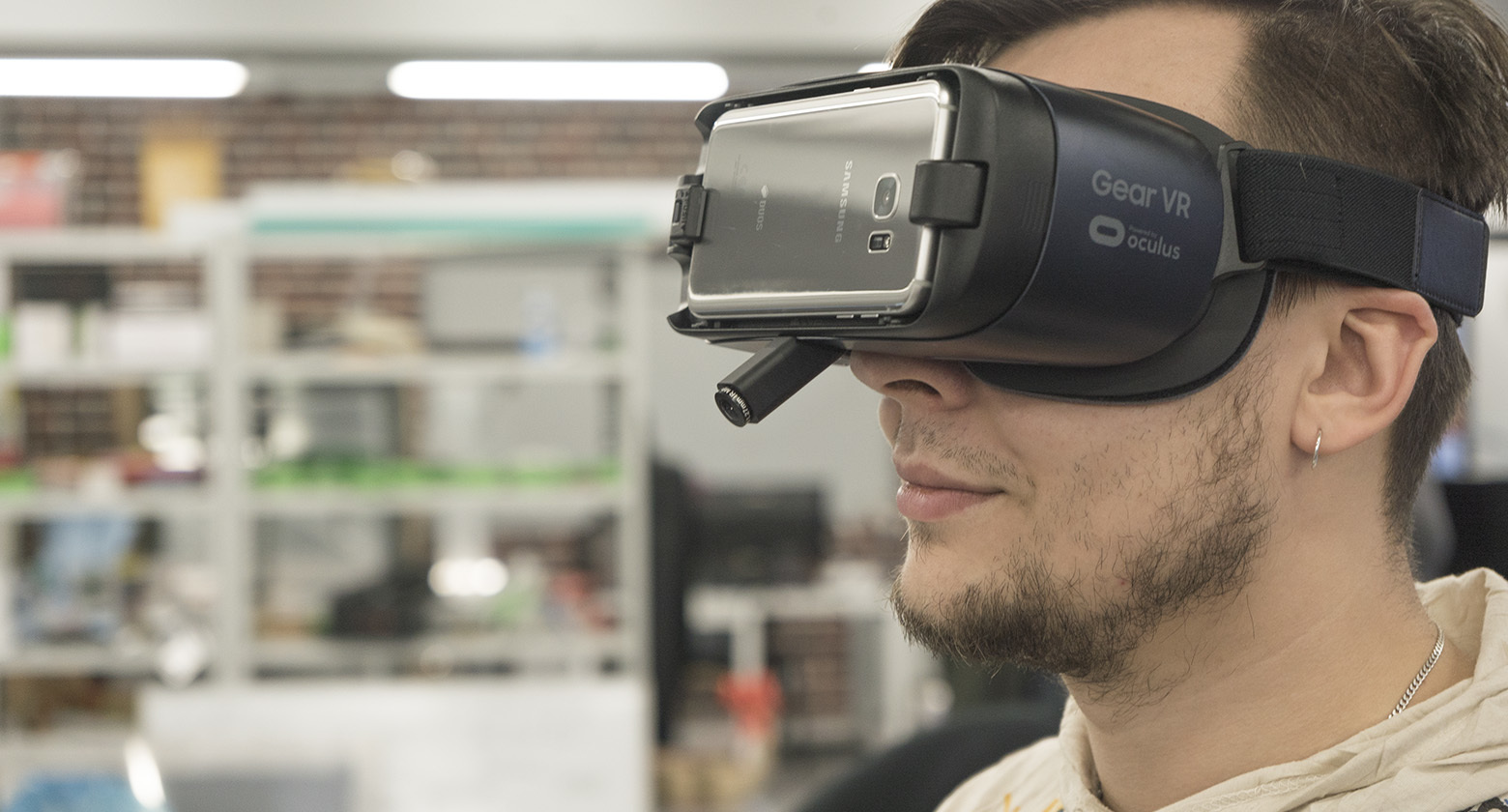
In fact, everything went completely wrong. In 2010, the company appeared Nettle. We began to develop holographic tables NettleBox . The basis for the device was its own tracking system that tracks the user's position. The plans of the team was to make the device massive. For this, it was necessary to create conditions for external content studios that could transfer their projects to our platform.
But time went by and experience showed that an expensive device ($ 28,000) is difficult to provide as a demo sample, which is necessary for partners to check the content. We needed to facilitate access to technology for small visualization studios. At that time, the thought came that the solution would be an inexpensive version of the tracking system for the developer, creating a MotionParallax3D display from what many have on hand, that is, 3D TV. Then the concept of the ALT (antilatency tracker) was born - a hybrid optical inertial inside-out tracker, which was supposed to become a kind of DevKit of the NettleBox tracking system. Reflecting on the concept of the device, we came to the conclusion that the tracker is not only a tool for solving our business problem, but also a full-fledged user device for holographic gaming . It looked attractive: AAA projects from a third party were interested in selling their products in VR, and HMD was originally conceived for 1st-person games.
')
As a result, a compact wireless microcamera was supposed to turn out, which would be attached to 3D glasses and would determine its own coordinates using the infrared markers.
The team started to develop.
The starting point was a lot of desire and an own camera for NettleBox with very decent features.
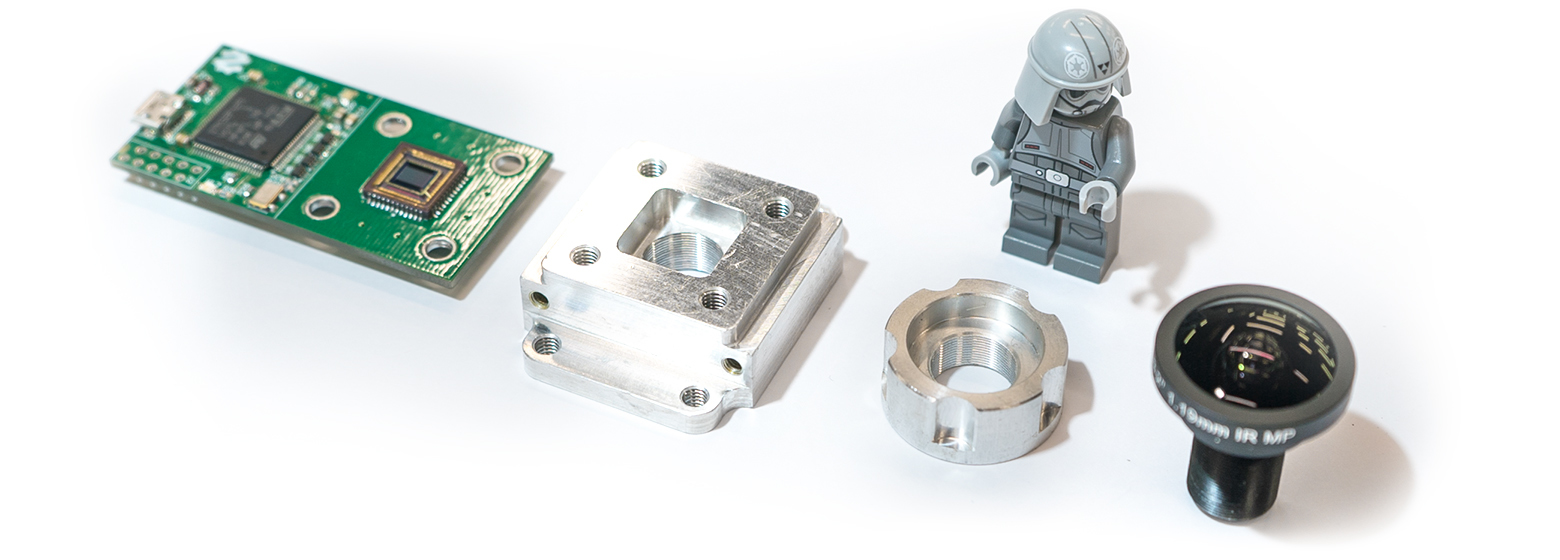
A standard startup path was chosen. Print prototypes on a 3D printer, and later, after the final design debugging, order a mold. After some time of discussion, the first design of our breakthrough device appeared: a sleek, streamlined, spacecraft-like device. Here it is.

And then came the moment X. In the office came a package with a prototype case, printed on a 3D printer.
Sweet moments of unpacking, sheets of wrapping paper torn off in anticipation, scraps of scotch, flying in rapid order around the office ... And for the first time, our crown of creation falls into the palm of the team.
Disgusting heresy! We decide unanimously.
The ribbed surface of the printed part was an expected phenomenon, but the dimensional accuracy left something to be desired, and printing the thread M12x0.5 turned out to be unreal in general. It took a long time to refine the part to simply insert the electronics and optics into it. Plus soft plastic did not allow to precisely hold the lens relative to the matrix; in our case, the offset by several microns was already unacceptable - it was necessary to re-calibrate the device. It became clear that 3D printing is not enough for us even for prototyping. The technology needed to be changed.
In addition, there were many questions to the design. Trying to place relatively rectangular electronics inside a streamlined body of irregular shape, we got a lot of voids. Because of this, with a small volume of components, the device externally was larger than it could be.

Began to think how to make the form more suitable for our tasks. In our arsenal, aluminum milling was rolled off at the NettleBox production and it was decided to put it back on board. Returning to aluminum, the team solved the problem of rigid attachment of the lens in the housing.
In parallel, the electronics were modernized and decreased. In the first case it was possible to place the battery only 100 mAh, this seemed to be small. We reduced the electronics using even the most up-to-date ideas, like placing one of the boards on the diagonal of the case.

In the process, an interesting aluminum extrusion technology was discovered for the production of electronics enclosures. For the most part, it is used to produce aluminum pipes. We decided that after receiving the profile of the desired shape, we would only have to mill the holes and cut it. The fact is that a long, thin body is an extremely unsuitable object for milling, therefore, the factory ordered the matrix for the production of the required aluminum profile, 16x16mm in size and 1mm wall thickness, to which were attached a demonstration 8 meters of profile. The minimum lot would be enough to start building a skyscraper or more than 55,000 buildings, each of which would cost six and a half cents.

Eureka! - the next design idea came to mind and we did not make an order, otherwise the sale of five hundred kilograms of aluminum would be a new topic for the survey. Despite the fact that we refused to solve the problem in this way - this technology is very viable in the production of hardware, so we will tell about it in more detail in one of the following articles.
The first working devices collected using those 8 meters of the profile that came with the matrix. The device came out compact, comfortable and very similar to what we wanted to achieve. This allowed us to try on the role of the player. Due to the increased battery capacity, the gadget weighed 34 grams, which caused controversy in the team. Is it too heavy a device and will the user not prefer the wired device to half the weight.
The fact is that the time of the gaming session (Remembering that we are dreaming of the concept of holographic gaming) is 3 hours, or even more, while the battery life is no more than two. At this moment, came the very idea: to split the device in half!
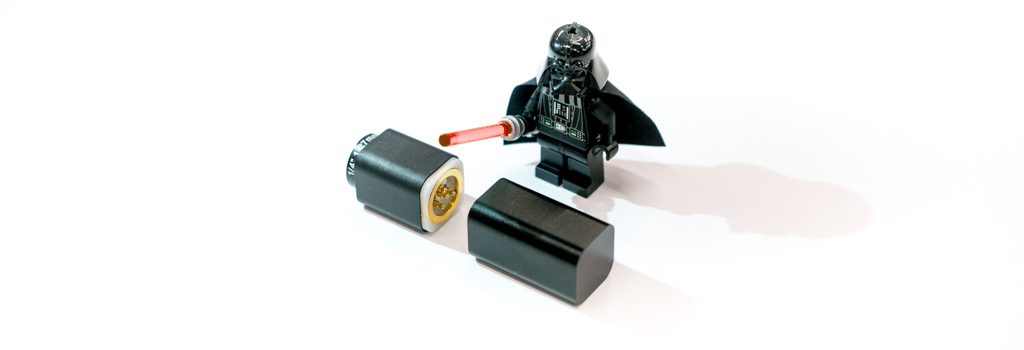
The infinite perfectionism of our technical director (* irony *) and common sense helped get rid of the controller placed diagonally and shove the electronics into 1 square centimeter of the board. For this, the approach to image processing was revised - we exchanged a powerful controller for a smaller controller plus FPGA. That's what we got at the exit.

In front of the device is iron: optics, gyroscope, accelerometer, "computing power", radio communications and power management. Now 60% of the volume in the main module of the device was occupied by optics.
The cases in this version are three times shorter and could be milled at a time. At this stage, we have discovered a new brave world of milling in China, which we will discuss in detail in one of our next articles.
The other part can be anything!
For example, this is a module with a battery or a micro-usb adapter. This solved our “problem” with a wired / wireless device. It became both. We solved the problem with charging the battery. Now, while one battery is discharged in the device - the other is charging in the charger. And it takes only 4 seconds to swap batteries. A bonus to solving our current tasks was that this approach made our device a general purpose tracker. The back of the device could be, for example, a quadrocopter, which would make it possible to repeat the exact movement during video recording.
According to the new concept, the two halves of the device were attached to each other by force.
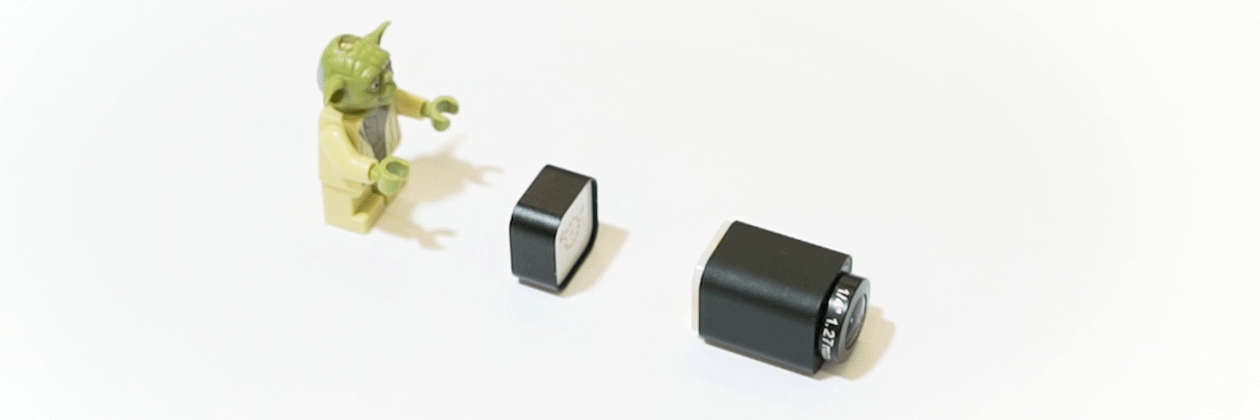
At the same time, as this thought came to us, the world was gaining a critical mass trend of virtual reality. Everybody tried like crazy to rank their companies as VR adepts. Large corporations put new incomprehensible tasks for managers in KPI, users read about incredible successes of the oculus and htc, google donated a cardboard to the world, and samsung started to give GearVR in a bundle with flagship smartphone models. And at this very moment we realized that we had a solution in our hands that would get Geary VRR from the shelf. It only remained to make a rear platform for it and port the software under the android.
What we have today:
Hybrid optical inertial tracker, which is oriented on tapes with infrared markers. The installation time of such a tracking system, provided that the software installed on the smartphone is no more than a minute. Unlike the usual tracking systems, where you need to add cameras to increase the area — you only need to add new marker lines to the inside-out approach, which is much cheaper. Several devices are oriented along the same tapes at once, which opens up multi-user scenarios. The line also has very bright LEDs, so the tracker can work outside even under the direct sun. Well, a pleasant bun will be the presence of game controllers, which can be a gun, and a tennis racket.
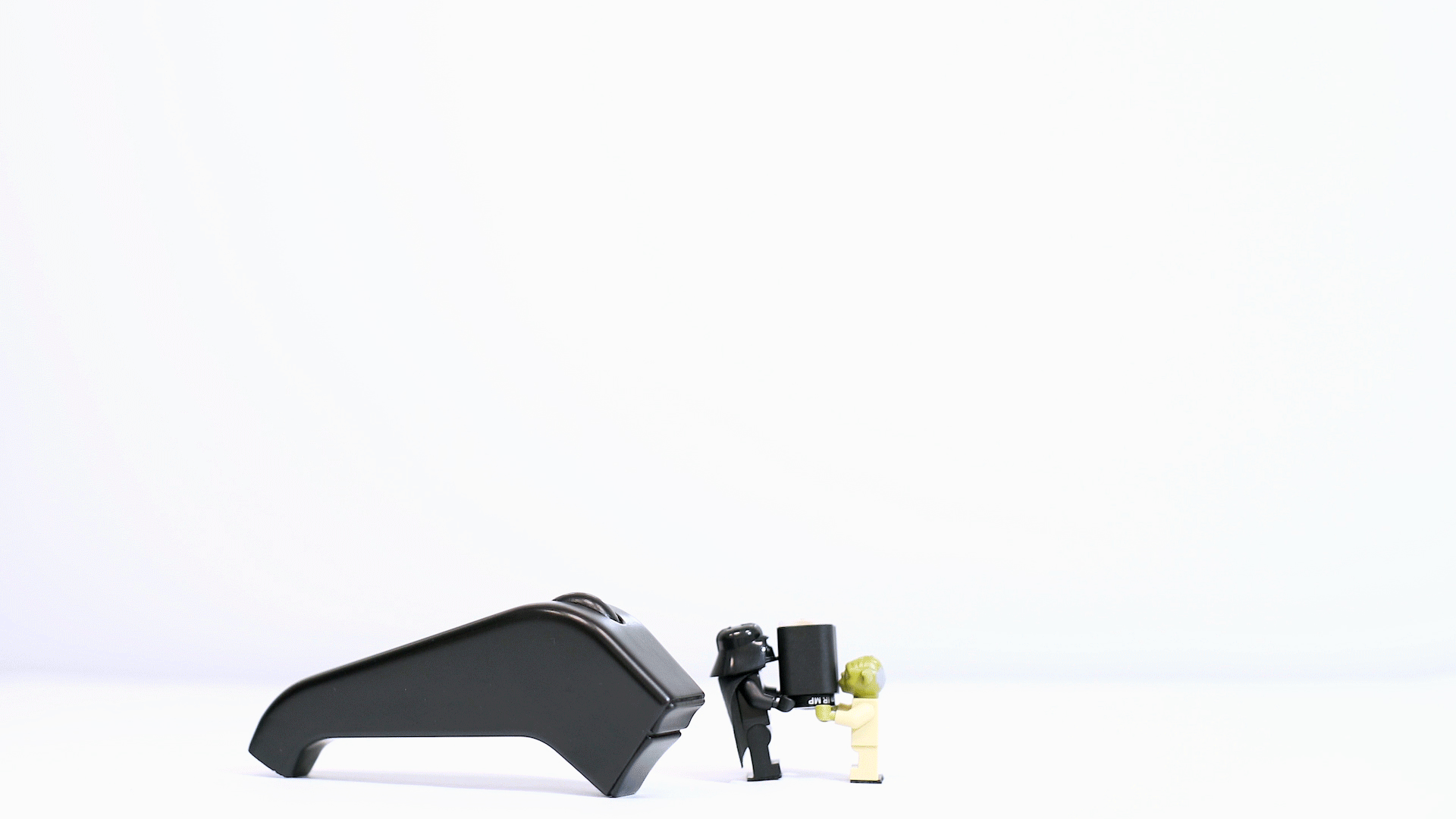
These two and a half pages of text are actually two years of R & D.
In the next series we will tell you how to work with Chinese factories, where to mill aluminum, how easier it is to fill molds with silicone, who has the fastest 3D printers; show the evolution of each component of our device - enclosures, boards, optics; share recipes, where and how to make cheaper and faster, open the solutions that are found during development.

May the magnet be with you!

In fact, everything went completely wrong. In 2010, the company appeared Nettle. We began to develop holographic tables NettleBox . The basis for the device was its own tracking system that tracks the user's position. The plans of the team was to make the device massive. For this, it was necessary to create conditions for external content studios that could transfer their projects to our platform.
But time went by and experience showed that an expensive device ($ 28,000) is difficult to provide as a demo sample, which is necessary for partners to check the content. We needed to facilitate access to technology for small visualization studios. At that time, the thought came that the solution would be an inexpensive version of the tracking system for the developer, creating a MotionParallax3D display from what many have on hand, that is, 3D TV. Then the concept of the ALT (antilatency tracker) was born - a hybrid optical inertial inside-out tracker, which was supposed to become a kind of DevKit of the NettleBox tracking system. Reflecting on the concept of the device, we came to the conclusion that the tracker is not only a tool for solving our business problem, but also a full-fledged user device for holographic gaming . It looked attractive: AAA projects from a third party were interested in selling their products in VR, and HMD was originally conceived for 1st-person games.
')
As a result, a compact wireless microcamera was supposed to turn out, which would be attached to 3D glasses and would determine its own coordinates using the infrared markers.
The team started to develop.
The starting point was a lot of desire and an own camera for NettleBox with very decent features.

A standard startup path was chosen. Print prototypes on a 3D printer, and later, after the final design debugging, order a mold. After some time of discussion, the first design of our breakthrough device appeared: a sleek, streamlined, spacecraft-like device. Here it is.

And then came the moment X. In the office came a package with a prototype case, printed on a 3D printer.
Sweet moments of unpacking, sheets of wrapping paper torn off in anticipation, scraps of scotch, flying in rapid order around the office ... And for the first time, our crown of creation falls into the palm of the team.
Disgusting heresy! We decide unanimously.
The ribbed surface of the printed part was an expected phenomenon, but the dimensional accuracy left something to be desired, and printing the thread M12x0.5 turned out to be unreal in general. It took a long time to refine the part to simply insert the electronics and optics into it. Plus soft plastic did not allow to precisely hold the lens relative to the matrix; in our case, the offset by several microns was already unacceptable - it was necessary to re-calibrate the device. It became clear that 3D printing is not enough for us even for prototyping. The technology needed to be changed.
In addition, there were many questions to the design. Trying to place relatively rectangular electronics inside a streamlined body of irregular shape, we got a lot of voids. Because of this, with a small volume of components, the device externally was larger than it could be.

Began to think how to make the form more suitable for our tasks. In our arsenal, aluminum milling was rolled off at the NettleBox production and it was decided to put it back on board. Returning to aluminum, the team solved the problem of rigid attachment of the lens in the housing.
In parallel, the electronics were modernized and decreased. In the first case it was possible to place the battery only 100 mAh, this seemed to be small. We reduced the electronics using even the most up-to-date ideas, like placing one of the boards on the diagonal of the case.

In the process, an interesting aluminum extrusion technology was discovered for the production of electronics enclosures. For the most part, it is used to produce aluminum pipes. We decided that after receiving the profile of the desired shape, we would only have to mill the holes and cut it. The fact is that a long, thin body is an extremely unsuitable object for milling, therefore, the factory ordered the matrix for the production of the required aluminum profile, 16x16mm in size and 1mm wall thickness, to which were attached a demonstration 8 meters of profile. The minimum lot would be enough to start building a skyscraper or more than 55,000 buildings, each of which would cost six and a half cents.

Eureka! - the next design idea came to mind and we did not make an order, otherwise the sale of five hundred kilograms of aluminum would be a new topic for the survey. Despite the fact that we refused to solve the problem in this way - this technology is very viable in the production of hardware, so we will tell about it in more detail in one of the following articles.
The first working devices collected using those 8 meters of the profile that came with the matrix. The device came out compact, comfortable and very similar to what we wanted to achieve. This allowed us to try on the role of the player. Due to the increased battery capacity, the gadget weighed 34 grams, which caused controversy in the team. Is it too heavy a device and will the user not prefer the wired device to half the weight.
The fact is that the time of the gaming session (Remembering that we are dreaming of the concept of holographic gaming) is 3 hours, or even more, while the battery life is no more than two. At this moment, came the very idea: to split the device in half!

The infinite perfectionism of our technical director (* irony *) and common sense helped get rid of the controller placed diagonally and shove the electronics into 1 square centimeter of the board. For this, the approach to image processing was revised - we exchanged a powerful controller for a smaller controller plus FPGA. That's what we got at the exit.

In front of the device is iron: optics, gyroscope, accelerometer, "computing power", radio communications and power management. Now 60% of the volume in the main module of the device was occupied by optics.
The cases in this version are three times shorter and could be milled at a time. At this stage, we have discovered a new brave world of milling in China, which we will discuss in detail in one of our next articles.
The other part can be anything!
For example, this is a module with a battery or a micro-usb adapter. This solved our “problem” with a wired / wireless device. It became both. We solved the problem with charging the battery. Now, while one battery is discharged in the device - the other is charging in the charger. And it takes only 4 seconds to swap batteries. A bonus to solving our current tasks was that this approach made our device a general purpose tracker. The back of the device could be, for example, a quadrocopter, which would make it possible to repeat the exact movement during video recording.
According to the new concept, the two halves of the device were attached to each other by force.

At the same time, as this thought came to us, the world was gaining a critical mass trend of virtual reality. Everybody tried like crazy to rank their companies as VR adepts. Large corporations put new incomprehensible tasks for managers in KPI, users read about incredible successes of the oculus and htc, google donated a cardboard to the world, and samsung started to give GearVR in a bundle with flagship smartphone models. And at this very moment we realized that we had a solution in our hands that would get Geary VRR from the shelf. It only remained to make a rear platform for it and port the software under the android.
What we have today:
Hybrid optical inertial tracker, which is oriented on tapes with infrared markers. The installation time of such a tracking system, provided that the software installed on the smartphone is no more than a minute. Unlike the usual tracking systems, where you need to add cameras to increase the area — you only need to add new marker lines to the inside-out approach, which is much cheaper. Several devices are oriented along the same tapes at once, which opens up multi-user scenarios. The line also has very bright LEDs, so the tracker can work outside even under the direct sun. Well, a pleasant bun will be the presence of game controllers, which can be a gun, and a tennis racket.

These two and a half pages of text are actually two years of R & D.
In the next series we will tell you how to work with Chinese factories, where to mill aluminum, how easier it is to fill molds with silicone, who has the fastest 3D printers; show the evolution of each component of our device - enclosures, boards, optics; share recipes, where and how to make cheaper and faster, open the solutions that are found during development.

May the magnet be with you!
Source: https://habr.com/ru/post/320204/
All Articles